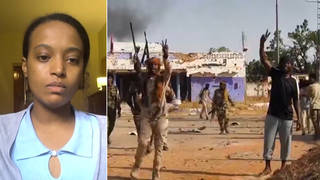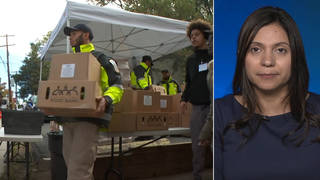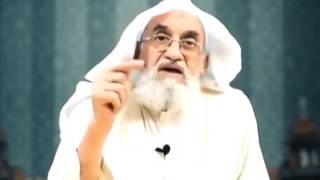
Topics
Guests
- Brandon Bryanta former sensor operator for the U.S. Air Force Predator program. He manned the camera on the unmanned aerial vehicles, commonly known as drones. After he left the active-duty Air Force in 2011, he was presented with a certificate that credited his squadron for 1,626 kills. In total, he says he was involved in seven missions in which his Predator fired a missile at a target.
We look at how the United States uses drones in war, and their impact, through the eyes of one of the first U.S. drone operators to speak out. Former U.S. Air Force pilot Brandon Bryant served as a sensor operator for the Predator program from 2007 to 2011, manning the camera on the unmanned aerial vehicles that carried out attacks overseas. After he left the active duty in the Air Force, he was presented with a certificate that credited his squadron for 1,626 kills. In total, Bryant says he was involved in seven missions in which his Predator fired a missile at a human target, and about 13 people died in those strikes — actions he says left him traumatized. “The clinical definition of PTSD is an anxiety disorder associated with witnessing or experiencing a traumatic event,” Bryant says. “Think how you would feel if you were part of something that you felt violated the Constitution.”
Transcript
JUAN GONZÁLEZ: We turn now to look at how the United States uses drones, and their impact—this time through the eyes of one of the first U.S. drone pilots to speak out. Former Air Force pilot Brandon Bryant served as a sensor operator for the U.S. Air Force Predator program from 2007 to 2011. He manned the camera on the unmanned aerial vehicles, commonly known as drones. After he left the active-duty Air Force, he was presented with a certificate that credited his squadron for 1,626 kills.
AMY GOODMAN: In total, Bryant says he was involved in seven missions in which his Predator fired a missile at a target, and about 13 people died in those strikes. He describes the grisly scenes he watched unfold on his monitor as an Air Force drone operator in a new article in GQ magazine, “Confessions of a Drone Warrior” by Matt Power. He joins us now in our New York studio.
Brandon Bryant, welcome to Democracy Now!
BRANDON BRYANT: Thank you for having me.
AMY GOODMAN: Place us in the room in 2007 with your first strike. Describe what happened.
BRANDON BRYANT: It was roughly around January 26, the end of January. And I had gotten on shift. I used to be what they called a multi-aircraft control qualified sensor operator, which is where a pilot controls multiple drones, and then a sensor operator controls one drone. So, you have a sensor operator basically in control of the aircraft until the pilot decides to take over. And that was my typical mission and would usually result in no shots being fired. And that—the day of my first shot, I was told to go in—
AMY GOODMAN: Where were you?
BRANDON BRYANT: I was in Nevada. And—
AMY GOODMAN: Which base?
BRANDON BRYANT: Nellis. And—
AMY GOODMAN: What did the room look like?
BRANDON BRYANT: The room? The room is not necessarily a room. It’s a trailer. It’s like a eight-by-20 trailer, kind of the same size as a Formula One racing car. And so, I was told to go in there and do this. And we came across—it was a troops-in-contact situation, where guys were firing from the top of a hill to guys on the bottom of a hill at—
AMY GOODMAN: In what country?
BRANDON BRYANT: Afghanistan. And the guys at the bottom of the hill were U.S. forces, and these guys were—needed air support. And the—we were about to fire on the guys on the top of the hill, and we were told to back off, and an F-16 was going to drop. But the F-16 came across three individuals a short distance away, and they wanted us to fire on those guys, because they thought that those guys were coming in to reinforce.
JUAN GONZÁLEZ: Now, this was a nighttime operation?
BRANDON BRYANT: Yeah, it was.
JUAN GONZÁLEZ: So you were basically dealing with infrared as you were looking at these figures?
BRANDON BRYANT: Correct. And so, when we came across these guys, the two individuals in the front were having a heated discussion, and you could see that they were talking about something. And the guy in the back was kind of watching the sky. And they weren’t really in a hurry to do anything. And so, we got the confirmation that they had weapons, and we were told to fire. And in that situation—
JUAN GONZÁLEZ: Now, does this confirmation come from troops in the field? Or does it come from—
BRANDON BRYANT: No, it came from somewhere else. You got to understand that the whole operation procedures is like a web, and, like, you’re dealing with people from multiple locations from all over the world. And so, when we—
AMY GOODMAN: You’re speaking—you’re hearing them in headphones, and you’re watching them on a computer monitor.
BRANDON BRYANT: Yeah, we’re like—there’s like a chat program. Like so, that’s the easiest way to communicate because of the satellite delay. But we weren’t in radio communications with anyone except for the guys that were on the ground, so we heard them asking for air support.
And so, we got confirmation to fire on these guys. And the way that they reacted really made me doubt their involvement, because the guys over there, the locals over there, have to protect themselves from the Taliban just as much as armed—us—we do, as U.S. military personnel. And so, I think that they were probably in the wrong place at the wrong time. And the way that—I’ve been accused of using poetic imagery to describe it, but I watched this guy bleed out, the guy in the back, and his right leg above the knee was severed in the strike. And his—he bled out through his femoral artery. And it—
AMY GOODMAN: You saw that on your computer screen?
BRANDON BRYANT: Right.
AMY GOODMAN: It’s that detailed?
BRANDON BRYANT: Yeah, it’s pixelated, but, I mean, you could—you could see that it was a human being, and you could see that—what he was doing, and you could see the crater from the drone—from the Hellfire missile, and you could see probably the body pieces that were around this guy.
JUAN GONZÁLEZ: And the other two that were in this strike?
BRANDON BRYANT: They were completely destroyed.
JUAN GONZÁLEZ: Blown apart.
BRANDON BRYANT: Blown apart.
AMY GOODMAN: So, you watched this guy bleed out for how long?
BRANDON BRYANT: You know, it’s the femoral artery, so he could have bled out really fast. It was cold outside, you know, wintertime. It seemed like forever to me, but we—as the Predator drone can stay in the air for like 18 to 32 hours, and so they just had us watch and do battle damage assessment to make sure that—to see if anyone would come and pick up the body parts or anyone really cared who these people were. And we watched long enough that the body cooled on the ground, and they called us off target.
JUAN GONZÁLEZ: Now, there was a—sometime later, you think that—you’ve written that you thought you killed a child, as well.
BRANDON BRYANT: There’s—yeah.
JUAN GONZÁLEZ: Could you talk about that particular day?
BRANDON BRYANT: That was—I was still feeling the effects of my first Hellfire shot. And, like, you have to understand that what we did over in Afghanistan and Iraq there, it’s constitutionally viable. We were given permission by the American public to go to war with al-Qaeda and the Taliban. And so, when this specific Hellfire shot, we were—the intel that we were given is that there was this commander and some of his people inside this building. And they had been watching it for multiple days. They had been keeping track of people that had gone in and out. And they had made the determination that those were the only people that were in there. And something ran around the corner, and it looked like a little person. And it made me realize that, you know, we can have all the intel in the world, and it’s still not going to be perfect. And as clean as these types of strikes can be, they’re in reality really dirty.
And military operations—being part of the military, talking about military operations, like, that’s—that’s just the nature of what it is. And the real—the real debate should be about places other than where we went to war and, you know, violating the constitutional rights of an American citizen who was in another country, who was killed without due process, and that type of thing. And my—my goal in all of this is to talk about, like, these aren’t killer robots. They’re not like unfeeling people behind this whole thing. There are—there are some people that are extremely scary when talking to them, and there was one individual who got the word “infidel” tattooed in Arabic on his side, and he had Hellfire tattoos marking every shot. But that’s an extreme. Most—
AMY GOODMAN: You mean who you work with, who was—
BRANDON BRYANT: Who I worked with.
AMY GOODMAN: —who was killing people on the computer—
BRANDON BRYANT: Right.
AMY GOODMAN: —with the drone strikes.
BRANDON BRYANT: Right. And that’s an extreme personality. But there’s a lot of like—those people are so few in the community, so few in the military, that—but they’re looked at as like that’s who everyone is. And that’s not the case. Like, there’s people behind there.
AMY GOODMAN: Brandon, in this case where you believe you killed a child, the report was written up as killing a dog?
BRANDON BRYANT: No, the report actually said enemies killed in action, executed to standards. Like, that’s what the after-action report said. It was very, very antiseptic, I guess is the word.
AMY GOODMAN: Mm-hmm.
JUAN GONZÁLEZ: And help me understand this. When you’re doing these drone strikes, is it basically you’re on duty for a set number of hours controlling one Predator, let’s say, or one drone that’s over a particular area, or are you specifically assigned to particular missions and called in?
BRANDON BRYANT: No. So, there’s a shift that goes on. So, there’s multiple shifts in the day. And typically, you are assigned a mission on that shift, because crew continuity is so viable. They want the same types of people on the same missions, because that means that less explanation has to happen between crews, and there’s more accountability there, internal accountability. And so, but the shifts, typically they were 11-and-a-half-hour shifts with a small break in the middle, where you’re flying four-and-a-half hours with a small break, four-and-a-half hours, or even longer depending on how many people we had available to fly that day.
AMY GOODMAN: Why have you decided, Brandon, to speak out?
BRANDON BRYANT: Because there’s so much misinformation out there, that—so much speculation, and—and that’s wrong. The United States government hasn’t really done a good job of humanizing the people that do it. And everyone else thinks that the whole program or the people behind it are a joke, that we are video-game warriors, that we’re Nintendo warriors. And that’s—that’s really not the case. And these—the people that do the job are just as legit and just as combat-oriented as anyone else. And I’m not like their official spokesperson. In fact, I’m probably the most hated person in the entire community right now.
AMY GOODMAN: Why?
BRANDON BRYANT: Because I have spoken out, and they’re—they’re hurt. They feel like I’m trying to hurt them, and that’s not the case. I’m trying to give them credence, you know? But the problem is, like, again, we’re going back to like the Constitution and what is viable and what is not inside and outside of war zones, what the people of the American—of America has permission—what they have given us.
JUAN GONZÁLEZ: I wanted to ask you about a certificate in which your squadron, the 3rd Special Operations Squadron at Cannon Air Force Base in New Mexico, was credited for 1,626 kills. Air Force Special Operations Command spokeswoman, Captain Belena Marquez, responded to your claims about this in an email to the Air Force Times. She wrote, quote, “Only a very small percentage of that [enemy killed in action] total can be attributed to any one crew member when assessing actual kinetic activity.”
BRANDON BRYANT: And I think that’s a—that’s the misconception there, is I’ve never taken credit for these kills. They’re not my kills. Like, I didn’t drop the bombs or shoot the people on the ground. These are all the number of people that have perished in all the operations that I was told that I participated in over the five-and-a-half-year period that I actually operated. And that’s a completely viable number, if you look at it. And some people could be surprised that it’s not larger. And if it’s the number that’s solely attributed to the 3rd Special Operations Squadron, then—and in the first place, I don’t know why they gave that certificate, or whatever it was, to me, because I never cared about it in the first place. But like—
AMY GOODMAN: Do you feel you suffer from post-traumatic stress disorder, PTSD?
BRANDON BRYANT: Well, you know, the clinical definition of PTSD is an anxiety disorder associated with witnessing or experiencing a traumatic event. And it’s such a blanket term that so many people are like, “Oh, you can’t get PTSD from this or that.” And it’s a widely—it’s a wider phenomenon than I think a lot of people realize.
And my deal is more moral injury, like think of it—think how you would feel when—if you were part of something that you felt violated the Constitution. And, I mean, I swore an oath, you know? I swore to defend the Constitution against all enemies, foreign and domestic. And how do you feel if, like—you can’t use “I obeyed orders” as an excuse. It’s “I obeyed the Constitution, regardless of lawful or unlawful orders.” And lawful orders follow the Constitution. And that, that’s the hardest part.
And I was really unprepared for—for it. I tried to get out multiple times and do a different job, and I was consistently told that it’s the needs of the Air Force come first, and so I did it. I buckled down, and I did it. I did the job. I did it as best as I could, because I was scared that someone would come in, and they wouldn’t do it very well. And I—I mean, I paid a spiritual and mental price for that. And I think that’s something that people really discount, because I didn’t take any physical injury through it.
AMY GOODMAN: Well, Brandon, I want to thank you for being with us. When I asked earlier about the dog, a child being identified as a dog, though it didn’t appear in the final report, it did come out in the chatter, right, as the killings were happening?
BRANDON BRYANT: Right. It said, upon—like, the person who was—I mean, there’s multiple people that review the feed, and the person that was in the chat said, “Upon further review, it was a dog.” So—
AMY GOODMAN: Well, I want to thank you for being with us. You’re going to speak today also at the United Nations?
BRANDON BRYANT: Yeah, I’ve been given a little—a little time to address the folks there. It’s a pretty big responsibility, I think.
AMY GOODMAN: Well, thank you for talking to us here at Democracy Now! Brandon Bryant is a former sensor operator for the U.S. Air Force Predator program, manned the camera on the unmanned aerial vehicles, commonly known as drones. After he left the active-duty Air Force in 2011, he was presented with a certificate that credited his squadron with 1,626 kills. This is Democracy Now! We’ll be back in a minute.












Media Options